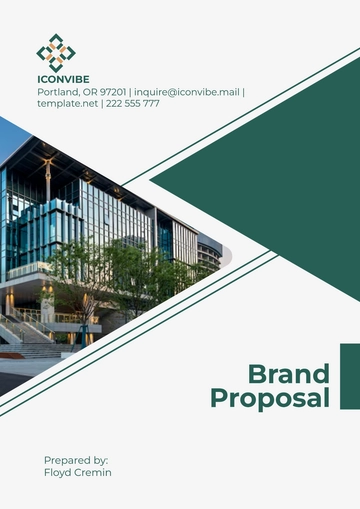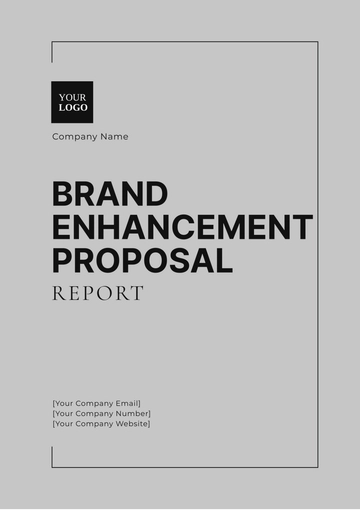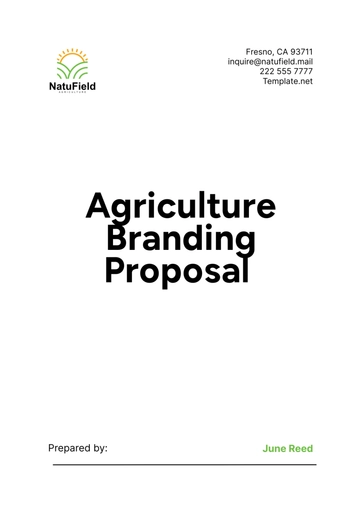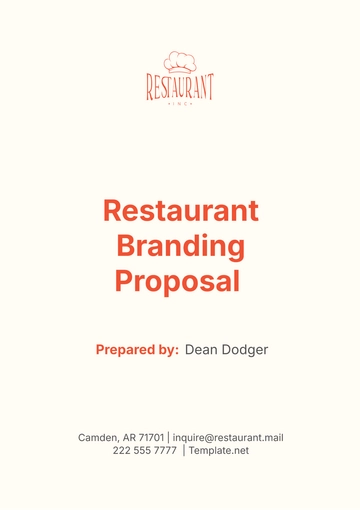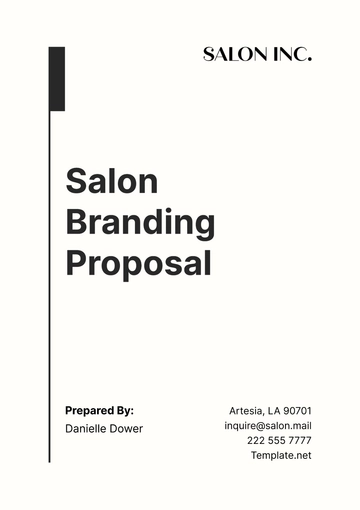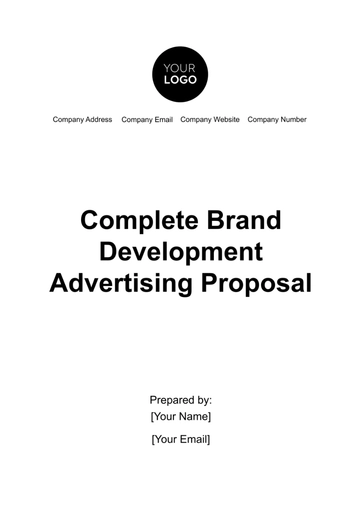Free Agriculture Branding Proposal
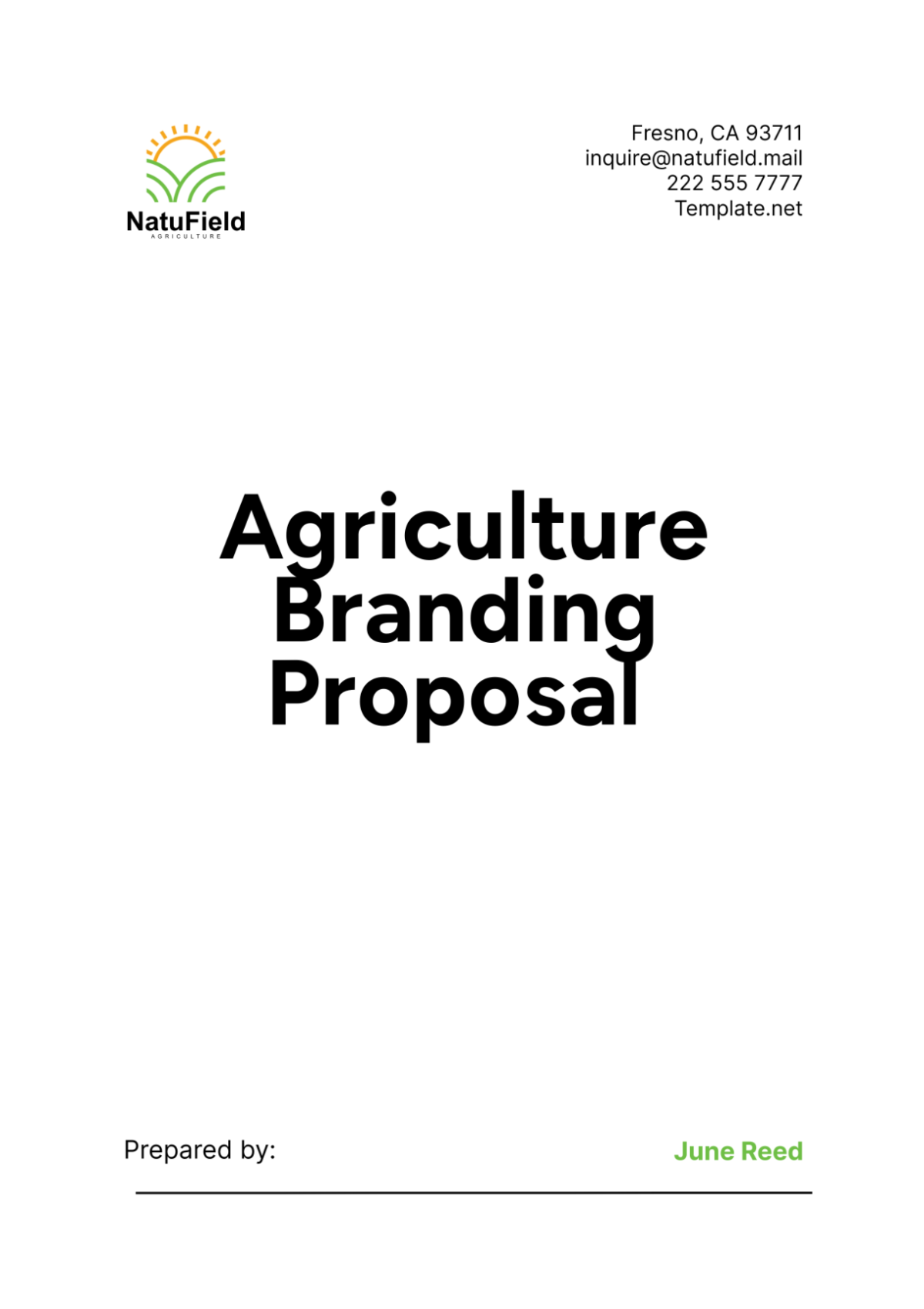
I. Executive Summary
A. Overview of Branding Proposal
The Agriculture Branding Proposal aims to strategically enhance the brand identity and market positioning of [Your Company Name]. This comprehensive proposal outlines key objectives, strategies, and implementation plans to strengthen brand equity and foster customer engagement.
B. Objectives and Goals
The primary objective of this proposal is to reposition [Your Company Name] as a leading provider of sustainable agricultural products in the market. Specific goals include increasing brand awareness, enhancing brand perception, and boosting customer loyalty through effective branding strategies.
C. Key Benefits
Enhanced Market Presence: By refining our brand identity and messaging, we aim to stand out in a competitive market.
Improved Customer Engagement: Clear and compelling brand communication will resonate better with our target audience.
Increased Sales and Revenue: Strengthening brand equity can lead to higher customer acquisition and retention rates.
II. Current Brand Analysis
A. Brand Identity
[Your Company Name] currently positions itself as a reliable supplier of high-quality agricultural products. The brand identity focuses on sustainability, quality assurance, and customer satisfaction.
B. Market Position
Currently, [Your Company Name] holds a strong position in the local agricultural market, known for its reliability and product quality. However, there is potential to expand our market reach and penetrate new customer segments.
C. SWOT Analysis (Strengths, Weaknesses, Opportunities, Threats)
Strengths:
Established brand reputation
High-quality product offerings
Strong customer relationships
Weaknesses:
Limited brand awareness beyond local markets
Opportunities for improvement in brand messaging
Opportunities:
Growing demand for organic and sustainable products
Expansion into new regional markets
Threats:
Intense competition from larger agricultural suppliers
Economic fluctuations affecting consumer spending
III. Target Audience
A. Demographic Profile
Our target audience includes farmers, agricultural cooperatives, and organic food distributors. Demographically, they range from small-scale farmers to large agricultural enterprises seeking sustainable and reliable product sources.
B. Psychographic Profile
They are environmentally conscious, value product quality and reliability, and seek suppliers with transparent and ethical business practices.
C. Market Segmentation
Small-scale Farmers: Focus on local markets and community-oriented initiatives.
Large Agricultural Enterprises: Emphasize bulk supply capabilities and reliability.
Organic Food Distributors: Highlight our commitment to organic farming practices and sustainable agriculture.
IV. Brand Positioning
A. Unique Selling Proposition (USP)
[Your Company Name] distinguishes itself through a commitment to sustainable farming practices and uncompromising product quality. Our USP lies in our ability to deliver fresh, organic produce directly from our farms to customers.
B. Brand Message
Our brand message revolves around sustainability, trust, and quality assurance. We emphasize our dedication to environmental stewardship and community engagement.
C. Brand Promise
[Your Company Name] promises to deliver premium-quality agricultural products while upholding the highest standards of sustainability and customer satisfaction.
V. Brand Strategy
A. Brand Vision and Mission
Vision: To be the preferred provider of sustainable agricultural products globally.
Mission: To cultivate and deliver nutritious, organic produce while promoting environmental responsibility and community prosperity.
B. Brand Personality
[Your Company Name]'s brand personality is genuine, trustworthy, and environmentally conscious. We aim to build emotional connections with our customers based on shared values of sustainability and quality.
C. Brand Values
Sustainability: Commitment to sustainable farming practices.
Quality: Consistent delivery of high-quality agricultural products.
Integrity: Ethical business practices and transparency.
VI. Branding Elements
A. Logo Design
The new logo will symbolize [Your Company Name]'s commitment to sustainability and quality. It will incorporate elements that resonate with our target audience, such as natural motifs and earth tones.
B. Color Scheme
A harmonious color palette of greens and browns will evoke nature and sustainability, reinforcing our brand's environmental focus.
C. Typography
Clean and modern typography will enhance readability and reflect our brand's professionalism and reliability.
D. Tagline
"Harvesting Sustainability, Nurturing Quality" encapsulates [Your Company Name]'s dedication to sustainable agriculture and superior product standards.
VII. Marketing and Communication Plan
A. Online Marketing Strategy
Website Development
[Your Company Name] will revamp its website to reflect the new brand identity and enhance user experience. Key features include:
Responsive Design: Ensuring compatibility across all devices.
Content Optimization: SEO-friendly content to improve search engine rankings.
E-commerce Integration: Facilitating online sales of agricultural products.
Interactive Elements: Engaging features such as blogs, customer testimonials, and product catalogs.
Social Media Strategy
Utilizing social media platforms to amplify brand awareness and engage with our target audience effectively. Strategies include:
Platform Selection: Focus on platforms like Facebook, Instagram, and LinkedIn based on audience demographics.
Content Calendar: Regular posting of content including educational posts about sustainable farming, product highlights, and customer stories.
Engagement Tactics: Responding promptly to customer queries and encouraging user-generated content to foster community engagement.
Email Marketing
Implementing targeted email campaigns to nurture leads and maintain customer relationships:
Segmentation: Segregating the audience based on interests, purchase history, and engagement levels.
Personalization: Customizing emails with relevant content and promotions.
Automation: Setting up automated workflows for welcome emails, product recommendations, and follow-ups.
B. Offline Marketing Strategy
Print Advertising
Strategic placement of print ads in industry publications and local newspapers to reach farmers and distributors:
Message Consistency: Aligning print ads with online campaigns to reinforce brand messaging.
Visual Appeal: Using high-quality images of our products and farm practices to attract attention.
Call to Action: Encouraging readers to visit our website or contact us for more information.
Events and Trade Shows
Participation in agricultural trade shows and local events to showcase our products and interact directly with potential customers:
Booth Design: Designing an attractive booth that reflects our brand values and attracts visitors.
Product Demonstrations: Conducting live demonstrations to highlight product features and benefits.
Networking Opportunities: Engaging with industry professionals and potential partners to expand our network.
Public Relations
Building positive media relations and enhancing brand credibility through strategic PR activities:
Press Releases: Issuing press releases about new product launches, sustainability initiatives, and company milestones.
Media Outreach: Pitching stories to relevant media outlets to secure editorial coverage.
Community Engagement: Supporting local community events and initiatives to strengthen brand presence and goodwill.
VIII. Brand Implementation Plan
A. Timeline
A detailed timeline outlining key milestones and deadlines for implementing the branding strategies:
Phase | Activities | Timeline |
|---|---|---|
Phase 1: Planning | Brand strategy development | Month 1 - Month 2 |
Phase 2: Execution | Website redesign, social media setup | Month 3 - Month 4 |
Phase 3: Launch | Launch new branding elements (logo, tagline), start campaigns | Month 5 |
Phase 4: Review | Monitor and evaluate campaign performance | Ongoing |
B. Budget
Allocating resources effectively to support the branding initiatives:
Category | Budget Allocation (USD) |
|---|---|
Website Development | $10,000 |
Social Media Marketing | $5,000 |
Print Advertising | $3,000 |
Events and Trade Shows | $7,000 |
Public Relations | $5,000 |
Miscellaneous Expenses | $2,000 |
Total Budget | $32,000 |
C. Key Milestones
Identifying critical milestones to track progress and ensure timely implementation:
Brand Identity Finalization: Month 2
Website Launch: Month 4
Social Media Campaign Kickoff: Month 3
Trade Show Participation: Month 6
Campaign Evaluation: Month 7
IX. Performance Metrics
A. Brand Awareness
Tracking metrics to measure the reach and recognition of [Your Company Name]:
Website Traffic: Monthly unique visitors and page views.
Social Media Reach: Number of followers, likes, shares, and comments.
Media Mentions: Quantifying press coverage and media mentions.
B. Customer Engagement
Assessing customer interaction and engagement levels across channels:
Social Media Engagement Rate: Calculating likes, comments, and shares per post.
Email Open Rate and Click-through Rate: Monitoring email campaign performance.
Event Participation: Evaluating attendance and feedback from trade shows and events.
C. Sales Growth
Monitoring the impact of branding efforts on sales revenue and customer acquisition:
Sales Conversion Rate: Percentage of leads converted into paying customers.
Revenue Increase: Comparing sales figures before and after the implementation of branding strategies.
Customer Retention Rate: Measuring customer loyalty and repeat purchases.
X. Risk Management
A. Potential Risks
Identifying potential challenges that may impact the successful implementation of the branding plan:
Potential Risk | Description |
|---|---|
Market Saturation | The agricultural market is competitive, with established brands dominating shelf space and consumer preference. |
Budget Constraints | Adhering to allocated budget for branding activities may limit the scope of marketing efforts and outreach. |
Technological Issues | Unforeseen technical glitches or delays during website development and digital marketing campaigns could disrupt timelines. |
Reputation Risks | Negative publicity or customer dissatisfaction due to product quality issues or environmental controversies. |
B. Mitigation Strategies
Developing proactive measures to mitigate risks and minimize their impact:
Mitigation Strategy | Description |
|---|---|
Competitive Analysis | Regular monitoring of competitor strategies to identify market trends and adjust our branding approach accordingly. |
Financial Oversight | Conducting regular budget reviews and adjustments to ensure optimal resource allocation and financial discipline. |
Contingency Planning | Developing contingency plans for critical activities and establishing protocols for rapid response to technical issues. |
Customer Relations | Implementing proactive customer service strategies to address concerns promptly and maintain positive brand reputation. |
XI. Conclusion
A. Summary of Proposal
The Agriculture Branding Proposal for [Your Company Name] outlines a comprehensive strategy to elevate our brand identity, enhance market presence, and foster customer engagement through integrated marketing and communication initiatives. By focusing on sustainability, quality, and customer satisfaction, we aim to differentiate [Your Company Name] in a competitive market landscape.
B. Long-term Vision
Our long-term vision is to establish [Your Company Name] as a global leader in sustainable agriculture, recognized for our commitment to quality, innovation, and environmental stewardship. Through continuous improvement and adaptation to market dynamics, we strive to exceed customer expectations and drive sustainable growth in the agricultural sector.
C. Call to Action
We invite stakeholders to support our branding initiatives and collaborate with us in achieving sustainable growth and success in the agricultural industry. Together, we can make a positive impact on farming practices, environmental conservation, and community well-being.
- 100% Customizable, free editor
- Access 1 Million+ Templates, photo’s & graphics
- Download or share as a template
- Click and replace photos, graphics, text, backgrounds
- Resize, crop, AI write & more
- Access advanced editor
Develop compelling branding strategies with Template.net's customizable and editable Agriculture Branding Proposal Template. Use the AI Editor Tool for detailed proposal creation. This user-friendly template ensures effective branding initiatives, enhancing market presence and brand recognition in your agricultural business.
You may also like
- Business Proposal
- Research Proposal
- Proposal Request
- Project Proposal
- Grant Proposal
- Photography Proposal
- Job Proposal
- Budget Proposal
- Marketing Proposal
- Branding Proposal
- Advertising Proposal
- Sales Proposal
- Startup Proposal
- Event Proposal
- Creative Proposal
- Restaurant Proposal
- Blank Proposal
- One Page Proposal
- Proposal Report
- IT Proposal
- Non Profit Proposal
- Training Proposal
- Construction Proposal
- School Proposal
- Cleaning Proposal
- Contract Proposal
- HR Proposal
- Travel Agency Proposal
- Small Business Proposal
- Investment Proposal
- Bid Proposal
- Retail Business Proposal
- Sponsorship Proposal
- Academic Proposal
- Partnership Proposal
- Work Proposal
- Agency Proposal
- University Proposal
- Accounting Proposal
- Real Estate Proposal
- Hotel Proposal
- Product Proposal
- Advertising Agency Proposal
- Development Proposal
- Loan Proposal
- Website Proposal
- Nursing Home Proposal
- Financial Proposal
- Salon Proposal
- Freelancer Proposal
- Funding Proposal
- Work from Home Proposal
- Company Proposal
- Consulting Proposal
- Educational Proposal
- Construction Bid Proposal
- Interior Design Proposal
- New Product Proposal
- Sports Proposal
- Corporate Proposal
- Food Proposal
- Property Proposal
- Maintenance Proposal
- Purchase Proposal
- Rental Proposal
- Recruitment Proposal
- Social Media Proposal
- Travel Proposal
- Trip Proposal
- Software Proposal
- Conference Proposal
- Graphic Design Proposal
- Law Firm Proposal
- Medical Proposal
- Music Proposal
- Pricing Proposal
- SEO Proposal
- Strategy Proposal
- Technical Proposal
- Coaching Proposal
- Ecommerce Proposal
- Fundraising Proposal
- Landscaping Proposal
- Charity Proposal
- Contractor Proposal
- Exhibition Proposal
- Art Proposal
- Mobile Proposal
- Equipment Proposal
- Student Proposal
- Engineering Proposal
- Business Proposal
